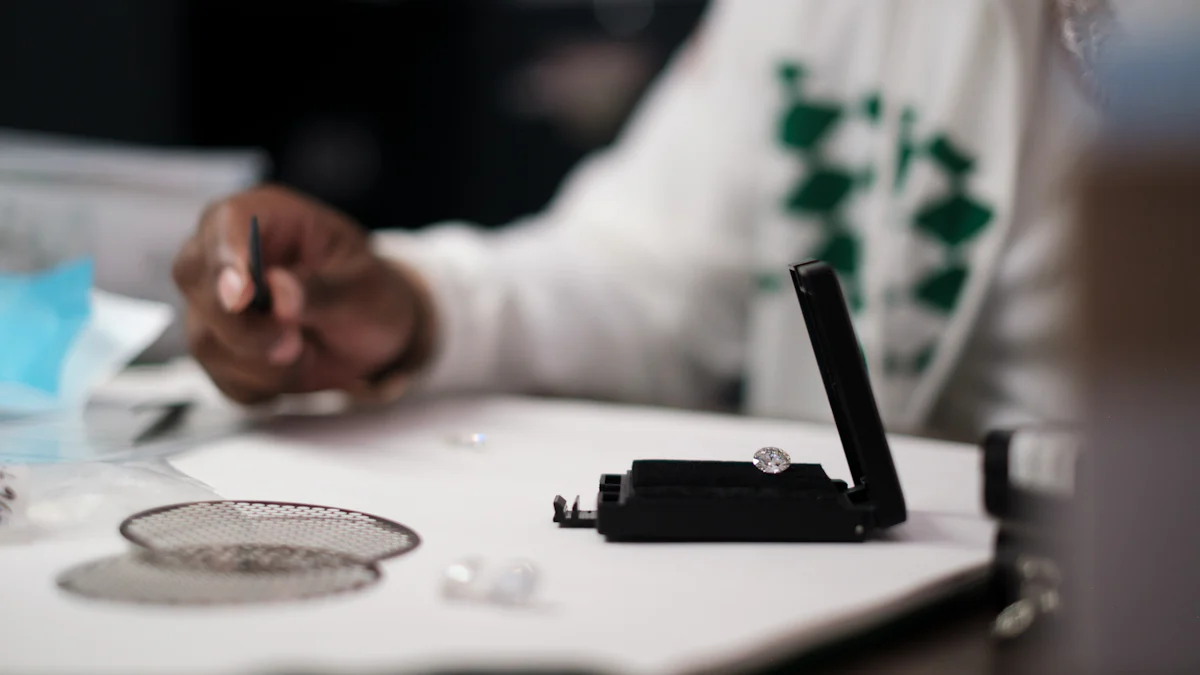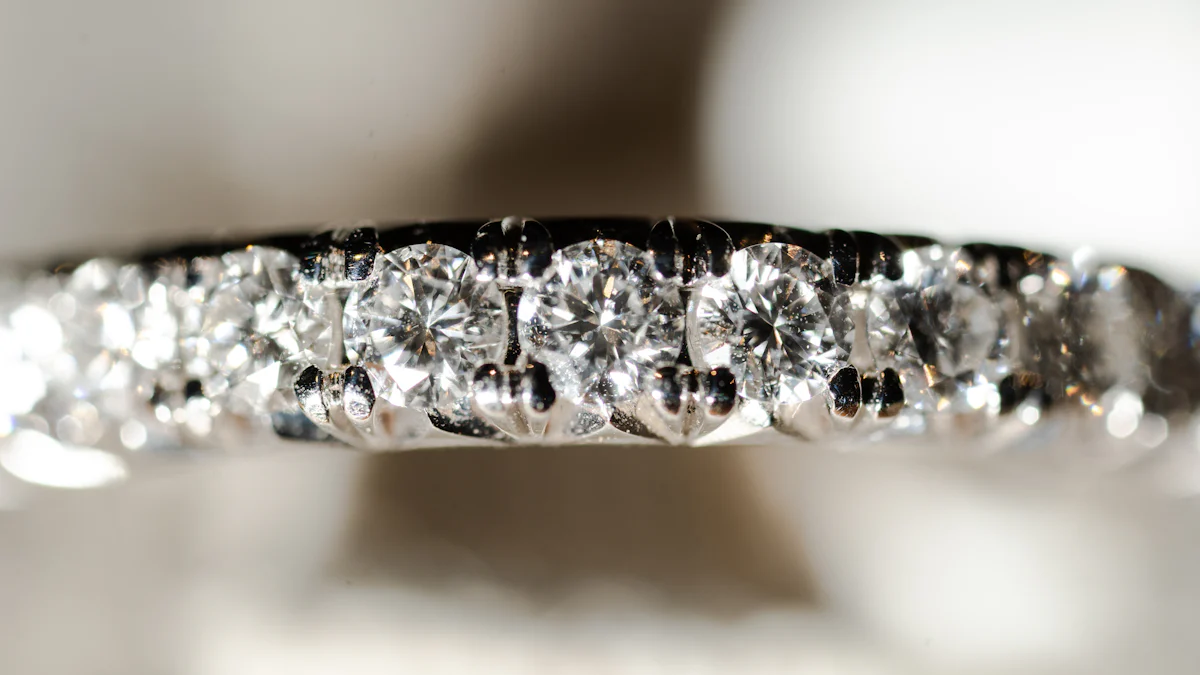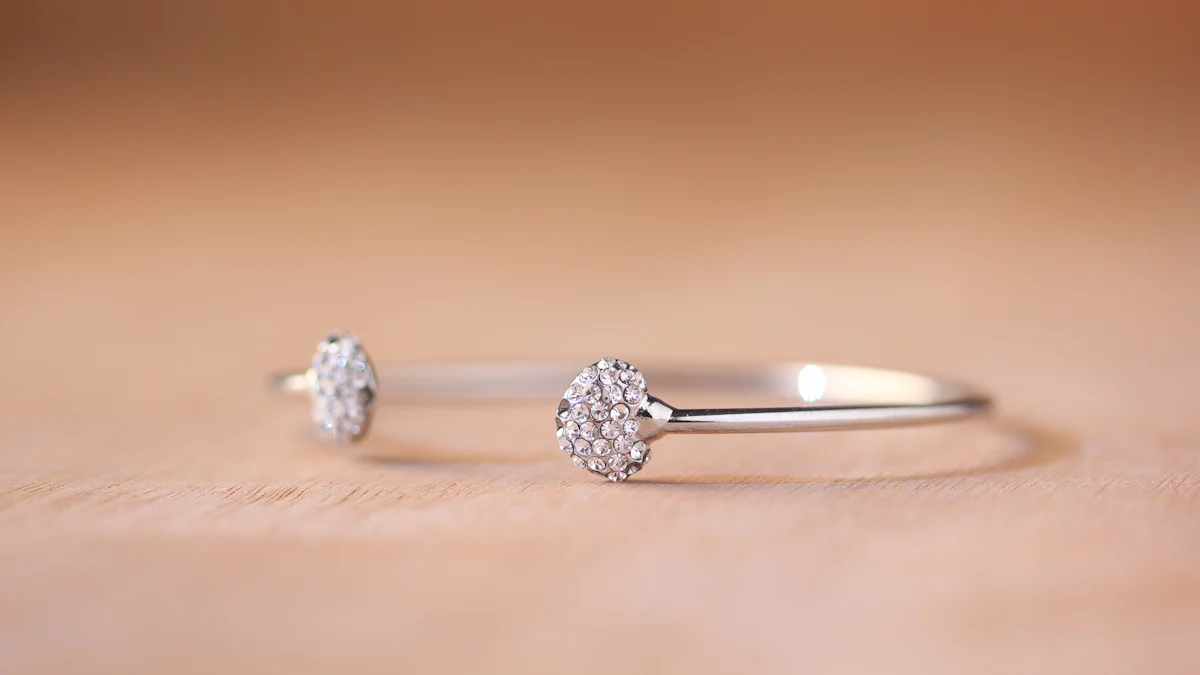The Evolution of VVS Diamonds Grading Standards

The grading standards for diamonds have transformed the way you assess their quality and value. Among these, the clarity grading of VVS diamonds stands out as a benchmark of excellence. The Gemological Institute of America (GIA) introduced a universal clarity scale in the mid-20th century, ensuring consistency in evaluating diamond purity. This system considers factors like inclusions' size, number, and location, offering you a reliable framework to trust. With advancements in technology, such as microscopy and AI tools, grading has become more precise, reinforcing your confidence in the diamond industry.
Key Takeaways
- Understand the clarity grading scale introduced by the GIA, which standardizes diamond evaluations and enhances trust in the diamond industry.
- Recognize the significance of VVS diamonds, classified as 'Very Very Slightly Included,' which offer exceptional clarity and beauty, making them highly desirable.
- Differentiate between VVS1 and VVS2 diamonds: VVS1 has nearly invisible inclusions, while VVS2 may have slightly more visible inclusions under magnification.
- Leverage advancements in technology, such as microscopy and AI, which provide precise grading and enhance your confidence in diamond quality.
- Be aware that standardized grading practices influence diamond pricing, ensuring consistency and transparency in the market.
- Support ethical and sustainable practices by choosing diamonds with verified origins, contributing to a responsible diamond industry.
- Stay informed about emerging technologies in grading, which promise to further enhance accuracy and transparency in diamond evaluations.
The Historical Development of Diamond Grading
Early Methods of Diamond Evaluation
In the early days of diamond trading, you would have relied on basic visual inspection to assess a diamond's quality. Traders and jewelers used rudimentary methods, often judging diamonds based on their size, color, and overall appearance. Without standardized tools or guidelines, evaluations varied widely. This lack of consistency made it difficult for you to trust the quality of a diamond or determine its true value.
During this period, clarity was not a formalized concept. Instead, you might have heard terms like "clean" or "blemished" to describe a diamond's appearance. These subjective descriptions left room for interpretation, which often led to disputes between buyers and sellers. The absence of a structured grading system highlighted the need for a more reliable approach to evaluating diamonds.
The Introduction of the Clarity Scale and VVS Diamonds
The mid-20th century marked a turning point in diamond grading. The Gemological Institute of America (GIA) introduced the clarity scale, revolutionizing how you assess diamonds. This scale provided a standardized framework, allowing you to evaluate diamonds based on specific criteria like inclusions and blemishes. For the first time, you could rely on a universal system to determine a diamond's quality.
Within this clarity scale, VVS diamonds emerged as a significant category. Standing for "Very Very Slightly Included," these diamonds represent the third and fourth levels of clarity, known as VVS1 and VVS2. Their inclusions are so minute that even under 10x magnification, they are challenging to detect. This level of precision brought a new level of trust and transparency to the diamond industry. When you choose a VVS diamond, you are selecting a gem that is nearly flawless, offering exceptional beauty and value.
The introduction of the clarity scale not only standardized diamond grading but also elevated the importance of clarity as a key factor in determining a diamond's worth. By understanding the clarity scale and the role of VVS diamonds within it, you gain a deeper appreciation for the craftsmanship and rarity of these gems.
The Role of the GIA in Shaping VVS Diamonds Grading Standards
Establishing Universal Grading Practices
The Gemological Institute of America (GIA) has revolutionized how you evaluate diamonds. Before the GIA's involvement, the diamond industry lacked a unified system for assessing quality. This inconsistency often led to confusion and mistrust. In response, the GIA introduced a standardized grading system in the mid-20th century. This system, known as the 4Cs—Clarity, Carat Weight, Color, and Cut—provided a universal language for diamond evaluation.
The clarity component of the 4Cs became a cornerstone of diamond grading. By defining clear criteria for inclusions and blemishes, the GIA ensured that you could trust the quality of a diamond, regardless of where it was purchased. This universal approach eliminated subjective evaluations and replaced them with objective standards. Today, the GIA's grading practices are recognized globally as the gold standard in the diamond industry. When you see a GIA certification, you know the diamond has been evaluated with precision and integrity.
Defining VVS Clarity Grades: VVS1 and VVS2
Within the GIA's clarity grading system, VVS diamonds hold a prestigious position. These diamonds, classified as "Very Very Slightly Included," represent an exceptional level of purity. The GIA further divides this category into two grades: VVS1 and VVS2. These distinctions depend on the size, number, and location of inclusions, which are so minute that even under 10x magnification, they are challenging to detect.
A VVS1 diamond has inclusions that are extremely difficult to spot, even for a trained gemologist. In contrast, a VVS2 diamond may have slightly more visible inclusions under magnification, but these remain invisible to the naked eye. This meticulous classification ensures that you can make informed decisions when selecting a diamond. By understanding the differences between VVS1 and VVS2, you gain insight into the rarity and value of these gems.
The GIA's efforts in defining and refining VVS clarity grades have elevated the importance of clarity in the diamond market. When you choose a VVS diamond, you are investing in a gem that combines beauty, rarity, and exceptional craftsmanship. The GIA's commitment to precision and transparency has made this possible, giving you confidence in your purchase.
Characteristics and Value of VVS Diamonds

Understanding VVS1 and VVS2 Diamonds
When you explore the world of diamonds, understanding the distinction between VVS1 and VVS2 diamonds becomes essential. Both belong to the Very Very Slightly Included (VVS) category, which signifies diamonds with exceptional clarity. These diamonds have inclusions so minute that even under 10x magnification, they are challenging to detect.
VVS1 diamonds represent the pinnacle of clarity within this category. Their inclusions are nearly impossible to spot, even for trained gemologists using magnification tools. This makes them highly desirable for those seeking perfection in their gemstones. On the other hand, VVS2 diamonds possess slightly more visible inclusions under magnification. However, these inclusions remain invisible to the naked eye, ensuring a near-flawless appearance.
The difference between VVS1 and VVS2 lies in the size, number, and location of inclusions. While both grades offer remarkable clarity, VVS1 diamonds are considered superior due to their higher purity. Choosing between the two depends on your preference for perfection and budget considerations. Regardless of the grade, both VVS1 and VVS2 diamonds deliver unmatched brilliance and beauty.
Why VVS Diamonds Are Highly Sought After
VVS diamonds hold a special place in the diamond market due to their exceptional quality and rarity. Their clarity ensures that they appear flawless to the naked eye, making them a top choice for engagement rings and fine jewelry. When you select a VVS diamond, you invest in a gemstone that radiates brilliance and elegance.
The rarity of VVS diamonds adds to their allure. Diamonds with such minimal inclusions are scarce, which enhances their value and desirability. Their near-perfect clarity allows light to pass through without obstruction, resulting in unparalleled sparkle and fire. This visual appeal makes them a symbol of luxury and sophistication.
Additionally, VVS diamonds are often associated with emotional significance. Their purity and brilliance make them ideal for marking special occasions or expressing deep sentiments. Whether you choose a VVS diamond for its aesthetic charm or its symbolic meaning, it represents a timeless investment in beauty and quality.
Technological Advancements in Grading VVS Diamonds

Microscopy and Precision in Clarity Assessment
Microscopy has revolutionized how you evaluate the clarity of diamonds. High-powered microscopes allow you to detect even the tiniest inclusions and blemishes that were once impossible to see. These tools provide a level of precision that ensures accurate grading, especially for diamonds in the VVS (Very Very Slightly Included) category. By magnifying a diamond up to 10x or more, microscopy helps you understand its internal structure and purity.
Modern imaging technologies complement microscopy by capturing detailed visuals of a diamond's inclusions. These images give you a clear view of the diamond's clarity characteristics, making it easier to assess its quality. Jewelers and gemologists rely on these technologies to provide you with transparent and reliable evaluations. This precision not only enhances the grading process but also builds your trust in the diamond's authenticity.
Microscopy has also improved consistency in grading. By using standardized tools, gemologists can ensure that diamonds are evaluated uniformly across the industry. This consistency benefits you by offering a dependable framework for comparing diamonds. When you choose a diamond graded with advanced microscopy, you can feel confident in its quality and value.
The Role of Digital Tools and AI in Modern Grading
Digital tools and artificial intelligence (AI) have transformed the diamond grading process. AI-driven systems analyze diamonds with remarkable speed and accuracy, eliminating the risk of human error. These systems use machine learning to improve over time, ensuring that each evaluation becomes more precise. For you, this means a more reliable and consistent grading experience.
One notable innovation is the use of digital mapping software. This technology creates a detailed map of a diamond's inclusions and blemishes, giving you a comprehensive understanding of its clarity. The software highlights even the smallest imperfections, helping you make informed decisions when selecting a diamond. By visualizing the diamond's internal features, you gain a deeper appreciation for its craftsmanship and rarity.
AI-based grading systems, such as the Sarine Clarity-II™, have further enhanced the industry. These systems sort diamonds efficiently based on their clarity, catering to market demands. For manufacturers and retailers, this streamlines the process of matching diamonds to customer preferences. For you, it ensures that the diamonds you see meet the highest standards of quality.
Digital tools and AI also contribute to transparency in the diamond market. By providing objective and data-driven evaluations, these technologies eliminate bias and subjectivity. When you purchase a diamond graded with AI, you can trust that its quality has been assessed with the utmost accuracy. This innovation not only improves the grading process but also strengthens your confidence in the diamond industry.
The Impact of Grading Standards on the Diamond Industry
Influence on Pricing and Market Trends
Grading standards have reshaped how you perceive diamond pricing and market trends. By introducing a universal grading system, organizations like the GIA have created consistency in pricing across the diamond industry. This standardization ensures that diamonds with similar characteristics, such as clarity, cut, and carat weight, are valued similarly, regardless of where you purchase them. You no longer need to worry about discrepancies caused by subjective evaluations.
The clarity grading of diamonds, including VVS diamonds, plays a significant role in determining their market value. A diamond with a higher clarity grade commands a premium price due to its rarity and visual appeal. For example, VVS diamonds, known for their exceptional clarity, often fetch higher prices compared to diamonds with lower clarity grades. This transparency in pricing helps you make informed decisions when investing in diamonds.
Market trends also respond to these grading standards. As consumer preferences shift toward higher-quality diamonds, the demand for diamonds with superior clarity grades, such as VVS diamonds, continues to grow. This demand influences pricing trends, making clarity a key factor in the diamond market. By understanding these trends, you can better navigate the market and choose diamonds that align with your preferences and budget.
Building Consumer Trust Through Standardization
Standardized grading practices have become the cornerstone of trust in the diamond industry. Before these standards existed, you might have faced uncertainty when evaluating a diamond's quality. Subjective assessments often led to confusion and mistrust. Today, the universal grading scale provides you with a clear and reliable framework to assess diamond quality.
When you see a diamond graded by a reputable organization like the GIA, you know it has undergone a rigorous evaluation process. This process eliminates human error and ensures accuracy, especially with the integration of advanced technologies like AI. AI-based grading systems analyze diamonds with precision, removing inconsistencies that could arise from subjective human judgment. This level of objectivity gives you confidence in the authenticity and quality of your diamond.
The standardized language used in grading reports further enhances transparency. Terms like "VVS1" and "VVS2" provide you with a clear understanding of a diamond's clarity. This common language allows you to compare diamonds easily, whether you're shopping locally or internationally. By relying on these standards, you can make well-informed decisions and trust that the diamond you choose meets your expectations.
In addition to fostering trust, these grading standards promote fairness in the industry. Jewelers and retailers adhere to the same criteria, ensuring that you receive consistent quality regardless of where you shop. This uniformity strengthens your confidence in the diamond-buying process and reinforces the industry's commitment to integrity.
Future Innovations in VVS Diamonds Grading
Emerging Technologies in Grading Practices
The diamond industry continues to embrace cutting-edge technologies to refine grading practices. These advancements aim to provide you with more accurate and consistent evaluations. Automated grading systems, powered by artificial intelligence (AI), have become a cornerstone of modern diamond assessment. These systems analyze diamonds with remarkable precision, identifying inclusions and blemishes that might escape the human eye. By eliminating human error, AI ensures that every diamond receives an unbiased and reliable grade.
AI-based grading relies on machine learning algorithms. These algorithms improve over time as they process more data, enhancing their ability to evaluate diamonds accurately. For you, this means a grading process that is not only faster but also more dependable. Digital mapping tools further complement these systems by creating detailed visual representations of a diamond's internal structure. These maps allow you to see the exact location and size of inclusions, giving you a transparent view of the diamond's clarity.
Technological advancements also include high-resolution imaging and spectroscopy. These tools capture intricate details of a diamond's composition, ensuring that no aspect of its quality goes unnoticed. When you choose a diamond graded with these technologies, you can trust that its evaluation reflects the highest standards of accuracy and transparency. The integration of these innovations strengthens your confidence in the diamond-buying process.
Sustainability and Ethical Considerations in Grading
As the diamond industry evolves, sustainability and ethics have become central to grading practices. You may wonder how these considerations impact the evaluation of diamonds, including VVS diamonds. The answer lies in the industry's commitment to responsible sourcing and environmentally friendly technologies. Grading labs now prioritize energy-efficient equipment and processes, reducing their carbon footprint while maintaining high standards of accuracy.
Ethical considerations also extend to the diamonds themselves. Many grading organizations now verify the origin of diamonds to ensure they are conflict-free. This verification process gives you peace of mind, knowing that your diamond purchase supports ethical practices. By choosing diamonds with verified origins, you contribute to a more sustainable and responsible industry.
In addition to sourcing, transparency plays a vital role in ethical grading. Advanced technologies, such as blockchain, are being used to track a diamond's journey from mine to market. This digital ledger provides you with a complete history of the diamond, ensuring that it meets ethical and environmental standards. When you invest in a diamond graded with these practices, you support a future where sustainability and ethics are integral to the industry.
The focus on sustainability and ethics not only benefits the environment but also enhances your trust in the diamond market. By aligning grading practices with these values, the industry ensures that you can make informed and responsible choices when selecting a diamond.
The journey of VVS diamonds grading standards reflects a remarkable evolution. From early subjective evaluations to the adoption of universal clarity scales, these advancements have transformed how you assess diamond quality. Technological innovations, such as AI-based grading tools, now ensure precision and consistency, boosting your confidence in every purchase. These standards not only safeguard valuation but also foster trust within the diamond industry. As grading practices continue to evolve, emerging technologies and ethical considerations promise a future where transparency and sustainability redefine the diamond market.
See Also
A Guide To Diamond Cuts For Engagement Jewelry
Exploring The History Behind Diamond Engagement Rings
Key Characteristics Of A Perfect Diamond Ring

